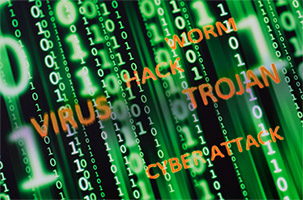Computer Attacks and Global Terrorism

It is problematic defining a “Cyberattack” such as “Cybercrime” or “Cyberterrorism” cause of difficult determining with certainty the identity, intent, or the political motivations of an attacker.
Often we equated simple use of malicious code with “Cyberterrorism” which usually involve more factors like just a computer hack. However, a “Cyberterrorism” event may also sometimes depend on the presence of other factors beyond just a “Cyberattack.”
There are many different definitions exist for the term “Cyberterrorism” like as many definitions exist for the term “Terrorism” [1]. Security expert Dorothy Denning [2] defines Cyberterrorism as “politically motivated hacking operations intended to cause grave harm such as loss of life or severe economic damage”. Some definitions of Cyberterrorism as “unlawful attacks and threats of attack against computers, networks, and the information stored therein when done to intimidate or coerce a government or its people in furtherance of political or social objectives” [3].
Others definitions indicate such as physical attacks that destroy computerized nodes for critical infrastructures, such as the Internet, telecommunications, or the electric power grid, without ever touching a keyboard, also be labeled as Cyberterrorism [4]. Thus, it is possible that if a computer facility were deliberately attacked for political purposes, all the methods described above (physical attack, Cyberattack etc.) might contribute to, or be labeled as “Cyberterrorism” .
Business, government and industry have all become addicted to information. Theirs depends of information creates opportunities for terrorism. Computer and information security, data protection, and privacy are all growing problems. No single technology or product will eliminate threats and risk. Securing our computers, information, and communications networks secure our economy and our country. A global strategy and policy for combating this type of terrorism is need now.
It is necessary to know that these methods of terror, producing destruction, and fear can be much more destructive online than other conventional methods in the real world.
To avoid much malicious possibility it is today’s research and development task to produce the crime-resistant products of the future. So we must take every opportunity we can to use science and technology to reduce crime and improve the quality of our lives. In this article we focused on different aspects of “Cyberterrorism”, their begin fundamentals and against fights methods.
References:
1. Under 22 USC, Section 2656, “terrorism” is defined as premeditated, politically motivated violence perpetrated against noncombatant targets by sub national groups or clandestine agents, usually intended to influence an audience. The United States has employed this definition of terrorism for statistical and analytical purposes since 1983. U.S. Department of State, 2002, Patterns of Global Terrorism, 2003, http://www.state.gov/ s/ct/rls/pgtrpt/2001/html/10220.htm.
2. Dorothy Denning, “Activism, Hactivism, and Cyberterrorism: The Internet as a tool for Influencing Foreign Policy,” in John Arquilla and David Ronfeldt, eds., Networks and Netwars, (Rand 2001), p. 241. Dorothy Denning, Is Cyber War Next? Social Science Research Council, November 2001, at http://www.ssrc.org/sept11/essays/ denning.htm.
3. http://www.fema.gov/pdf/onp/toolkit_app_d.pdf.
4. Dan Verton, “A Definition of Cyber-terrorism”, Computerworld, August 11, 2003, http://www.computerworld.com/securitytopics/security/story/ 0,10801,83843,00.html.
Comments close